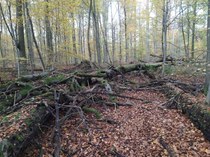A spot on the Beech: Fungal community patterns within & among Fagus woody debris (FWO-INBO)
Glen Dierickx (2020-2024)

The Sonian forest reserve in Belgium is a rare example of Atlantic beech forest, as is evident from its status as a UNESCO world heritage site. In such a natural forest, high amounts of dead wood are an essential component and key to the survival of many organisms. Fungal communities on dead wood are highly diverse and play important roles in the forest ecosystem. 20 years ago, decaying beech logs were surveyed in the Sonian forest as part of the first broadscale, international initiative investigating fungal communities on beech (EU NAT-MAN project).
In this project I will combine these historical datasets with resurveys, incorporating extensive existing datasets on dead wood properties, chemical wood composition and ectomycorrhizal fungi.
I will analyze the development and succession of the fungal community during decay by surveying subsets of the exact same logs.
Potential shifts in the fungal community as such will be evaluated by comparing similar subsets of logs over the two sampling periods. This will also be done on a European scale, including historical sites in Denmark and Slovenia.
Most importantly, the surveys will be expanded to include fine woody debris, and fruitbody surveys on the logs will be supplemented and compared to results from 3rd generation environmental sequencing. In this context, additional focus will be given to ectomycorrhizal fungi occurring in the late decay stages of the dead wood, and their potential linkages to ectomycorrhizal fungi that are essential to natural regeneration of beech seedlings.
My final goal is twofold. First, I want to get a comprehensive view on fine-scale community patterns during decay. Second, my results will evaluate 3rd generation sequencing as a tool for monitoring fungal diversity. Both goals will contribute towards and be translated into practical guidelines for forest managers.